
copyright © Wartime Heritage Association
Website hosting courtesy of Register.com - a web.com company
Wartime Heritage
ASSOCIATION
"Stretcher Bearer. Two Men Hit"
"Stretcher Bearer. Two Men Hit"
Battle At Courcelette, September 15 - September 16 1916
On the evening of September
15, 1916, the Canadians of the 25th
Battalion had driven the Germans out
of the town of Courcelette.
Lindsay Rogers, a thirty-four
year old soldier from Yarmouth, Nova
Scotia was a Private with the
Battalion.
The Canadians dug themselves
in just in front of the town. “When
we we going over a number of
Germans came over No Man’s Land
with their hands up.” The artillery
barrage had given the Germans “an awful pounding and they
were pretty well shaken.”
Some of the German soldiers ran while others surrendered.
When the Canadians got at close quarters the surrendering
Germans, a tired and a worn-out group, held up their hands and
were shouting “Mercy Comrades”
The Canadians having captured the German positions found
themselves with German biscuits, tinned meat, black bread,
what they knew as brown bread. This came in quite handy as
the Canadians were only able to carry light rations. That night,
Private Lindsay Rogers would have a drink of soda water,
compliments of the Germans.
The Germans were still on a ridge at right angles to the
Canadians and the next morning, September 16, started sniping
the Canadian positions.
“A bullet cut a twig over the Colonel’s head. I was cleaning
my rifle at the time and I said to a Sergeant next to me, ‘snipe
away, Fritz. But tomorrow it will be ‘Mercy Comrade.’”
The words had hardly escaped the mouth of Pte. Lindsay
Rogers when he received what seemed like a blow from a club
over his head.
“I fell on my face and I thought I was done for. I could hear
and think but could not move hand or foot. I could hear the
others shouting, ‘Stretcher Bear. Two men hit’”.
“I felt myself sinking into a great dark pit and seemed to
be dropping down and down. Then, I gathered all my strength
for a final effort and said to myself: ‘No, I won’t go.’”
Pte. Rogers opened his eyes and called out. The soldier
next to him got his field dressing and put it on the wound and a
stretcher bearer tied the dressing up properly. The bullet had
passed completely through his neck and killed the Sergeant he
had been talking to and who was standing next to him.
“After a while I got control of my limbs and laid down in
the trench on a German coat and stayed there all day. Fritz,
thinking we were in the town, bombarded it but we fooled him
as we had dug our trenches 100 yards in front of it. All he did
was to smash up some old houses and kill a few rats.”
That night at dark Private Rogers and two other soldiers,
one each side of him went out of the trenches.
“We made a dash through the town with ‘coal boxes’
shells which emitted heavy black smoke when they burst landing
all about us. It was a long trip over the shell torn ground and
trenches. Whenever I stepped on a low spot it jarred my neck
quite a bit.”
“At the dressing station the doctor put me on a stretcher.
From there I went to a Clearing Hospital and then to the
Canadian Hospital. Then on to Calais where we took the boat to
Dover. Thence to Newcastle on Tyne, just four days after
wounded. The doctors say I had a close shave shave and asked
me if I felt paralysed. A doctor said, ‘You should be a dead
man’”.
Robert Lindsay Rogers was the only son of Joseph R. and
Anne Rogers, of Yarmouth, Nova Scotia. He enlisted at
Yarmouth, with the 40th Battalion, on February 8, 1915.
Having recuperated from his wound, September 16, 1916,
Private Rogers returned to the trenches in France.
Eleven months later to the day, August 16, 1917, he was
killed as he charged across ‘No Man’s Land’.
Also see:
Private Robert Lindsay Rogers - 25th Battalion
Sources:
Photo Credits: Canada. Dept. of National Defence/Library and
Archives Canada/
“A Monument Speaks” A Thurston; 1989 (pp 288-291)

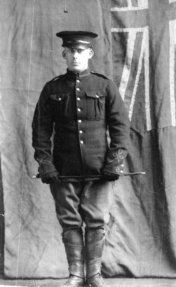
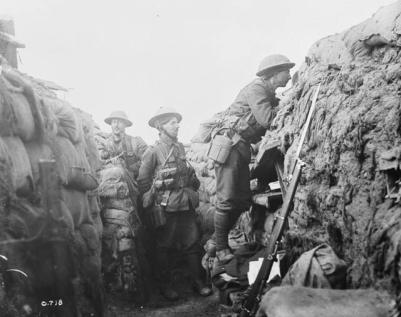
Canadian Trenches 1916
Canadian Trenches (1916) On sentry duty.
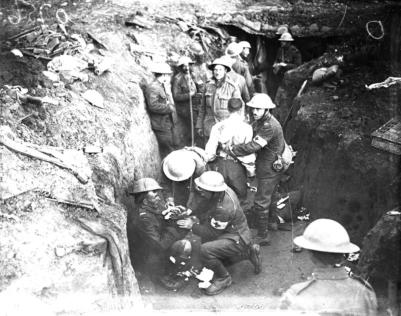
Canadian Trenches (1916) First aid for the wounded at Courcelette,
September 1916.
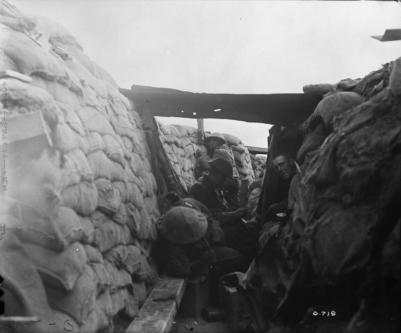
Canadian Trenches (1916)
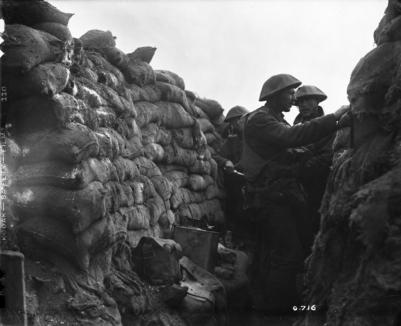
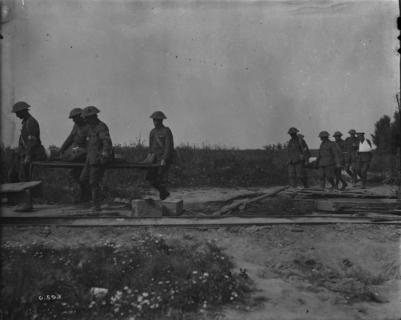
Canadian wounded being carried at a trench railway (1916)


- World War I - Menu
- WWI Stories and Articles
- Photos - Yarmouth Soldiers
- Selection of World War I Songs
- WWI Casualties of Yarmouth, NS
- Those Who Served - Yarmouth, NS
- WWI Casualties Digby Co. NS
- WWI Casualties Shelburne Co. NS
- Merchant Mariners (1915) Yarmouth, NS
- Canadian Forestry Corps - Non Yarmouth Birth/Residence Enlistments
- US Draft Registry - Yarmouth NS Born


- World War II - Menu
- WWII Stories and Articles
- Telegraphist Air Gunners
- WWII Casualties of Nova Scotia
- US Casualties with NS Connection
- Far East/Pacific Casualties with NS Connection
- Merchant Navy Casualties Nova Scotia
- Nova Scotia WWII Casualties Holten Canadian War Cemetery
- D-Day Casualties - Nova Scotia
- CANLOAN Program Casualties - Nova Scotia
- Battle of the Bulge Casualties - Nova Scotia
- WWII Casualties Yarmouth NS
- Yarmouth Casualties - RCAF RAF Canadian Army WWII
- Yarmouth Co., Marriages WWII
- Casualties Non-Born/Residents with Connection to Yarmouth Co., Nova Scotia.
- WWII Casualties Digby Co., NS
- Non-Nova Scotian WWII Casualties Buried in Nova Scotia
- WWII RCAF Casualties Aged 16-18
- Brothers/Sisters Who Served - World War II














